
POWDER COAT AND NEITHER-NORS
In North America, a silver-like phenomenon called "powder coat" has been noted in some breeds, but different breeders have different interpretations of “powder coat.” It is not an official term and there is no clear consensus on what “powder coat,” let alone what causes it. For some, powder coat means a lighter (softer) colour cat while “high colour” indicates a darker colour. This reflects the variations in colour depth attributed to polygenes in solid colour cats. Presumably it also coccurs in patterned cats but is less visible. For example some breeders regularly see “light chocolate” and “dark chocolate” in chocolate breeding lines, while some creams are intense enough to look like pale reds. In the past, these were known as "neither-nors" by the cat fancy because they were, for example, neither good creams nor good reds.
Powder coat, according to other breeders, looks as though the tips of the hairs are lighter than the base, giving the impression of a cat very lightly dusted with talcum powder, not just a cat that is uniformly paler in tone. Others say that, in their experience, powder coat also produces a metallic undertone; in the redseries cats this produces "hotter creams” rather than paler ones.
Some believe powder coat to be an alternative theory to the Dilute Modifier (caramel) gene for subtle coat colour changes. Caramel adds a brownish – some say muddy - tint to the underlying colour, though some cats with the Dilute Modifier also look paler in colour.
Powder coat must not be confused with "fever coat" (also called frosted coat). Fever coat is a temporary affect, usually seen in kittens, where the colour does not properly develop due to temperature in the womb or due to raised body temperature when new fur is growing. Fever coated kittens can resemble smokes (silver non-agouti) cats even though the silver gene (inhibitor gene) is not present. See Indefinable Kitten Colours.
The inheritance of powder coats is predictable. In some Burmilla and Burmese lines, powder coats have been linked to unexpected silver offspring (mismating being ruled out) leading the breeders to wonder if powder coat is due to a hypostatic silver gene. In another relative of the Burmese, the Singapura, Silver Singapuras appear where the ivory/cream colour is replaced by a very pale cream that is almost white.
Until a consensus is reached on the visual appearance of powder coat, rather than applying the name to multiple visual effects, we simply don’t know how, or if, it is related to silver, golden or wideband, or some othe genes that further dilute the base colour.
In general, breeders think in binary terms because genes occur in pairs. In an ideal world, a cat is either dense or dilute, it is either silver or not silver. The problem with this way of thinking is that other genes can modify the expression of colour, making it more or less intense. Selective breeding tries to produce consistent tones, but if a cat also inherits a particular mix of other genes (or epigenes that affect gene expression) it may turn out to be one of the neither-nors - a rather dark dilute or a washed-out dense colour.
